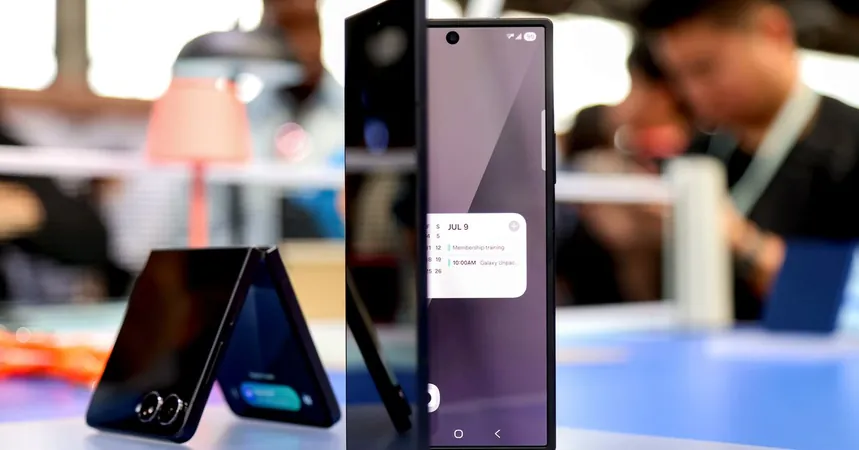
Samsung's Foldable Phones: An Indicator of China's Tech Dominance
2025-07-11
Author: Ling
Samsung Unveils Latest Foldable Phones
This week, Samsung showcased its newest high-end foldables at the Summer Galaxy Unpacked event, unveiling the Galaxy Z Fold7 and Galaxy Z Flip7. Despite being lighter, thinner, and boasting reduced creasing, these devices come with a higher price tag. Some tech enthusiasts are dubbing them the foldables to beat, but are they really?
A Familiar Story
The buzz surrounding these new models feels uncomfortably repetitive, echoing sentiments from past launches. While Samsung fans may have loved the previous versions, comparing the Z Fold7 with innovations from Chinese competitors casts Samsung in a somewhat lackluster light. It begs the question: Is this iteration of Samsung's foldables genuinely innovative, or just part of a never-ending cycle of minor improvements?
China's Consumer Tech Victory
While Samsung aims for incremental upgrades, China's tech landscape is flourishing with groundbreaking advancements. Chinese brands are revolutionizing consumer technology, especially evident in the electric vehicle (EV) sector. Recent events, like the Shanghai Auto Show, showcased this stark contrast, where China’s offerings outperformed their Western counterparts.
Foldable Phone Showdown
Take the foldable industry, for instance. Honor, a Chinese brand, beat Samsung to the punch by launching its sub-9mm foldable, the Magic V5, just a week prior to Samsung's event. While Samsung has set the standard for foldable technology, competitors are rapidly closing the gap.
Battery Power Play
Chinese manufacturers like Oppo aren’t just aiming for the same specs as Samsung; they're pushing boundaries. Oppo's Find N5, released earlier this year, features a stylus-compatible design and a silicon-carbon battery, allowing for a massive 5600 mAh capacity compared to Samsung's 4400 mAh—while maintaining the same thickness. With 80-watt fast charging, Oppo’s model leaves Samsung's latest in the dust.
The Race for Innovation
Huawei is also in the mix, unveiling their Mate XT, a trifold design that expands from a portable size into a tablet. It represents the pinnacle of foldable technology, displaying complex engineering that Samsung has yet to match. Despite expectations for Samsung to announce a similar innovative model, no such reveal occurred.
The Marketing Gap
Why are Chinese brands so quick and daring in launching new technology while Samsung seems hesitant? The answer lies in consumer desire for novelty. According to industry experts, Chinese consumers have progressed through multiple smartphones and now actively seek unique devices. In fact, China commands the largest foldable phone market, with two-thirds of foldables sold globally.
The Geopolitical Landscape
Government support for tech giants like Huawei and BYD has also played a significant role in their innovation, as billions in subsidies help propel these brands forward. Despite US sanctions, Huawei's growth story as a local hero resonates strongly with consumers.
China's Future Innovation Landscape
Experts suggest we're on the brink of another 'China Shock,' similar to the manufacturing shift of years past. This new wave could see China dominate advanced technologies, including semiconductors and AI. With companies like BOE, a leading display manufacturer, powering innovations, the dominance of Chinese smartphone brands is set to continue.
What Lies Ahead for Samsung?
As Apple prepares its rumored foldable smartphone, the competition from Chinese brands is fierce—challenging the West to innovate more aggressively. With the current trajectory, Chinese tech brands are not just catching up; they are actually leading the charge in innovation. Will Samsung be able to reclaim its crown in this rapidly evolving landscape?

 Brasil (PT)
Brasil (PT)
 Canada (EN)
Canada (EN)
 Chile (ES)
Chile (ES)
 Česko (CS)
Česko (CS)
 대한민국 (KO)
대한민국 (KO)
 España (ES)
España (ES)
 France (FR)
France (FR)
 Hong Kong (EN)
Hong Kong (EN)
 Italia (IT)
Italia (IT)
 日本 (JA)
日本 (JA)
 Magyarország (HU)
Magyarország (HU)
 Norge (NO)
Norge (NO)
 Polska (PL)
Polska (PL)
 Schweiz (DE)
Schweiz (DE)
 Singapore (EN)
Singapore (EN)
 Sverige (SV)
Sverige (SV)
 Suomi (FI)
Suomi (FI)
 Türkiye (TR)
Türkiye (TR)
 الإمارات العربية المتحدة (AR)
الإمارات العربية المتحدة (AR)